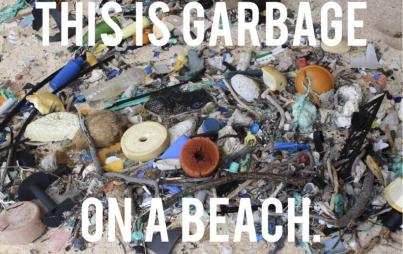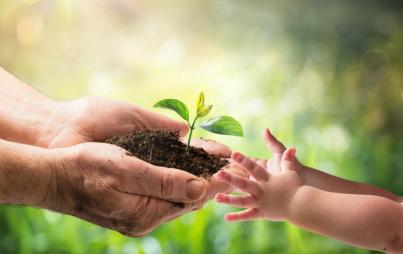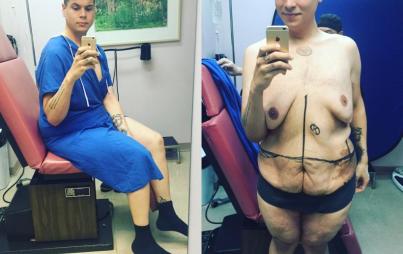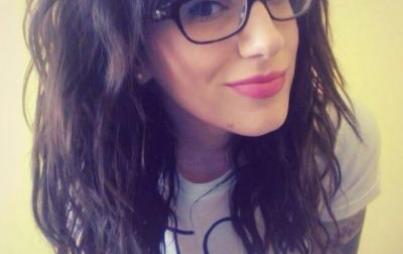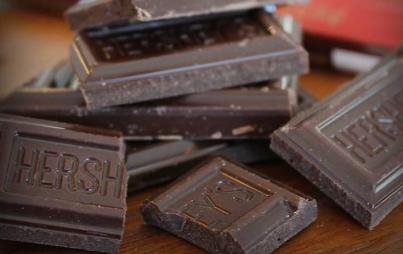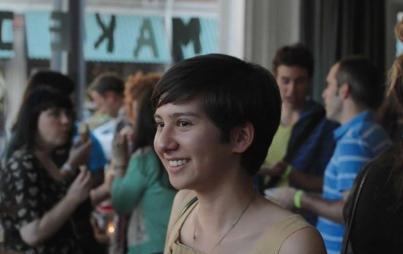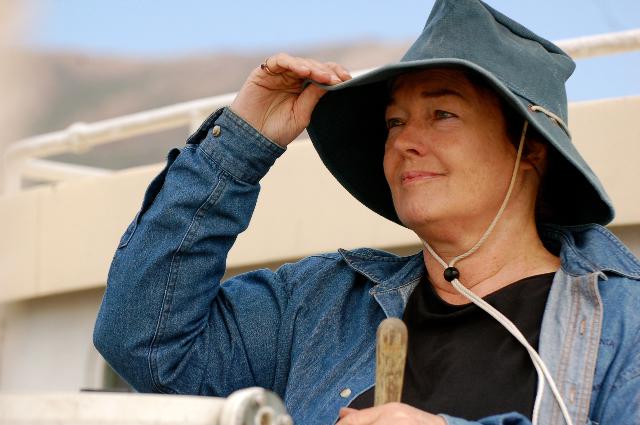
We have a huge problem: our oceans are filling with plastic, this plastic is killing the Earth's marine life at alarming rates and the chemicals from the plastics are leeching into our food sources.
But while you eat with your plastic forks and knives on your disposable plastic plates and drink from your disposable plastic cups, Mary Crowley and her team of volunteers are in the ocean pulling out your disposable plastic ware from a week ago . . . and a month ago . . . and a year ago. Crowley is the head of Project Kaisei, an ocean initiative that is working around the clock to clean up our plastic mess.
The Project is an initiative through Ocean Voyages Institute, a nonprofit also founded by Crowley. Each year, Project Kaisei sends a ship on a month-long expedition to the North Pacific Gyre, better known as the "Great Pacific Garbage Patch," to pull as much plastic and derelict fishing gear from the ocean as they can.
Crowley recently stepped out of the ocean to discuss Ocean Voyages and the Project Kaisei.
What is Ocean Voyages, exactly?
Back in 1979 I founded Ocean Voyages Inc., which is an international yacht chartering business that offers a full range of services. We have educational sailing programs, sailing vessels, expedition ships, motor yachts and scuba and snorkeling programs all over the world. Our programs are in Greece and Turkey, all over the Mediterranean, the Americas and we also do a lot in the Galapagos Islands and off of Ecuador. We also cover the South Pacific and Asia, the Indian Ocean, Arctic and Antarctic—really every place in the world!
Where is your favorite sailing destination? And would you rather be at sea or at the destination?
I love being at sea. Ecuador is one of my favorite places in the world. I have been lucky enough to go there 23 times, several times on month-long expeditions that I was leading. And all of French Polynesia is also a really magical part of the world to sail. I really like the Cook islands, New Guinea, the Solomon Islands, also Thailand. I have been blessed to sail in many beautiful parts of the world.

Ocean Voyages Institute is focused on teaching people to sail. Where did the idea to teach kids come from?
People were always saying, “Oh, it’s so wonderful you get to do all these things, how can I do something like that?” And I really loved the idea of providing access for people to this oceanic world. At the same time I started Ocean Voyages, Inc. I started Ocean Voyages Institute, which is a nonprofit institute that has a mission of preserving the maritime arts and sciences, the ocean environment and the island culture—in other words, teaching people about sailing and taking vessels to sea.
I have been interested in ocean conservation since I was a child and part of why I started Ocean Voyages was my belief that being in the ocean and experiencing these beautiful oceanic parts of the world is really healthy and good for people. People are going to care about preserving what they get to know and love and experience.
You have been working with Ocean Voyages for 35 years. Are you still teaching at the institute?
I sometimes will get involved with programs, but my time is mostly spent designing wonderful vacation trips for people or working with scientists to do scientific expeditions and also I’m very focus on the issue of plastics in the ocean.
And what is Project Kaisei about?
For about six years, Ocean Voyages Institute has gotten particularly involved in the issue of plastic garbage and pollution in our global ocean. I have led expeditions out to the North Pacific Subtropical Convergence Zone—that is Project Kaisei, held within Ocean Voyages Institute.
I put together a think tank of naval architects, marine engineers, oceanographers, fishermen and all sorts of ocean industry experts. With the information that we have gathered on the variety of month-long expeditions, we are figuring out the most efficient ways to clean up this debris from the ocean. We work very closely with a wonderful team of oceanographers at the University of Hawaii who are experts on ocean currents and who track the debris in the ocean. They help us figure out what part of the ocean to go to.
I watched the documentary on the projectkaisei.org website and there's quote that says, “If nobody is taking on cleaning this up, I’d better do it.” Is that where the idea for this project originated?
Many of the people around the world who are living on boats will contact me and say, “Wow, all of the sudden we were in the South Pacific or sailing to Hawaii and there was all this garbage around us.” And because I have been able to explore many parts of the world over the years, I have experienced personally how much garbage there is in the middle of the ocean, on beaches or just off shore. As I began studying more and more about it, and encountering people who would say, “This is such a massive problem there’s just nothing we can do about it,” I got really motivated. There’s a sentiment that it is a massive problem, and it’s a problem that our technology and our lifestyle and our carelessness has created. So, it certainly is a problem that we can, and must, work at solving.
Can you tell me about the effects of the debri in the ocean?
Well, every year a certain percentage of the plastic in the gyres gets spun out during storms and over 300,000 marine mammals get killed each year by either ingesting plastics or getting tangled in plastics. A young sperm whale had 400 pounds of plastic in his stomach and starved to death. Coral reefs will also get killed because derelict fishing gear like ghost nets will collect other plastics and then they end up on the reefs and smother them. And some small fish, as well as larger fish, eat little pieces of plastic, which means plastics are getting in our food chain as well.
How is this problem created? And what can we do about it?
People sort of envision that the problem is created because people throw garbage into the ocean, and that is true, some people do throw garbage into the ocean. However, a lot of the problem is created where there is a plastic bag or a plastic container that is next to a garbage pail because the garbage pail is full and the plastic blows away. You can have plastic that starts out in the middle of the country and ends up in the ocean.
It’s really just learning to be conscious when you share a planet with millions of people. We have to care about the way we’re living and how it influences the health of the planet. We need to do that by being able to teach people that we don’t need all of these disposable plastics, and that we should figure out ways to refuse disposable plastics and other packaging. And to reuse and recycle.
This work sounds really challenging and heartbreaking. What keeps you going?
The bad news is that we’ve all been part of creating this problem, the good news is that we can all be part of solving it. It feels really good to make little changes and be part of the solution. This is a problem that we can solve. One of the big things to do is to gently educate the people around you. People will want to join you.
Your life is based around the ocean! Have you always loved the water?
I’ve always loved the ocean and ocean sailing as well as swimming and snorkeling and scuba diving. I was lucky to get to experience these things myself by being a crew member and a captain and a teacher.

Is Project Kaisei completely run by volunteers?
Yes, occasionally we will hire a captain or an engineer or a first mate. Sometimes we support scientists who are doing relevant work, but I’m a volunteer and our think-tank and our board of directors is all volunteers.
How often does the Project Kaisei team go out to sea?
Typically about once per year, sometimes twice. It’s all a matter of funding and projects.
Media outlets are calling the North Pacific Gyre a giant island of trash, which gives us the visual image of a trash mountain floating around in the middle of the ocean. Do you have a better classification for it?
At this point in time the gyres aren’t giant islands of trash— it feels more like we’re sailing through a giant garbage dump.
There are 5 major gyres around the world, do the other gyres experience the same sort of “trash islands?”
Oh yes. We care about promoting cleanup all over the world. We’ve have been focusing on the North Pacific Gyre because it’s right in our backyard.
Do you have any tips for how we can help preserve our environment?
- Use reusable bags: there are all sorts of good reusable products for getting fresh vegetables that actually keep them fresh longer than using plastic.
- Carry a reusable water bottle: I don't think people understand that avoiding water bottled in plastic is not only good for the environment, but it’s also better for your health.
- Pay a lot of attention to the way you pack school lunches.
- When you find yourselves with plastic, be sure that it can be recycled and make sure that it’s not going to find its way into the natural environment.
If you're interested in learning more about Project Kaisei, check out the documentary at projectkaisei.org.

